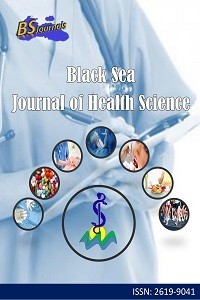Chemical Composition and Antibacterial Activity of Three Volatile Oils Extracted from Nigella sativa L. Seeds
Nigella sativa L., Volatile oil, Essential oil, Antibacterial activity
Chemical Composition and Antibacterial Activity of Three Volatile Oils Extracted from Nigella sativa L. Seeds
Nigella sativa L., Volatile oil, Essential oil, Antibacterial activity,
___
- Ahmad A, Husain A, Mujeeb M, Khan S A, Najmi A K, Siddique N A, Damanhouri Z A, Anwar F. 2013. A review on therapeutic potential of Nigella sativa: A miracle herb. Asian Pac J Trop Biomed, 3(5): 337-352.
- Aksit H, Bayar Y, Simsek S, Ulutas Y. 2022. Chemical composition and antifungal activities of the essential oils of Thymus species (Thymus pectinatus, Thymus convolutus, Thymus vulgaris) against plant pathogens. J Essent Oil-Bear Plants, 25(1): 200-207.
- Alkis H, Demir E, Taysi M R, Sagir S, Taysi S. 2021. Effects of Nigella sativa oil and thymoquinone on radiation-induced oxidative stress in kidney tissue of rats. Biomed Pharmacother, 139: 111540.
- Almatroudi A, Khadri H, Azam M, Rahmani A H, Al Khaleefah F K, Khateef R, Ansar M A, Allemailem K S. 2020. Antibacterial, antibiofilm and anticancer activity of biologically synthesized silver nanoparticles using seed extract of Nigella sativa. Processes, 8(4): 388.
- Bakal S N, Bereswill S, Heimesaat M M. 2017. Finding novel antibiotic substances from medicinal plants—antimicrobial properties of Nigella sativa directed against multidrug resistant bacteria. Eur J Microbiol Immunol, 7(1): 92-98.
- Burits M, Bucar F. 2000. Antioxidant activity of Nigella sativa essential oil. Phytother Res,14(5): 323-328.
- Cristani M, D'Arrigo M, Mandalari G, Castelli F, Sarpietro M G, Micieli D, Trombetta D. 2007. Interaction of four monoterpenes contained in essential oils with model membranes: implications for their antibacterial activity. J Agric Food Chem, 55(15): 6300-6308
- Daoudi H, Bouafia A, Meneceur S, Laouini S E, Belkhalfa H, Lebbihi R, Selmi B. 2022. Secondary metabolite from nigella sativa seeds mediated synthesis of silver oxide nanoparticles for efficient antioxidant and antibacterial activity. J Inorg Organomet Polym Mater, 32(11): 4223-4236.
- Erdoğan Ü, Özmen Ö, Özer M. 2023. Wound Healing, Anti-analgesic, and Antioxidant Activity of Nigella sativa Linn., Essential Based Topical Formulations in Rat Model Experimental Skin Defects. J Essent Oil-Bear Plants, 26(1): 45-60.
- Hossain M S, Sharfaraz A, Dutta A, Ahsan A, Masud M A, Ahmed I A, Goh B H, Urbi Z, Sarker M M R, Ming L C. 2021. A review of ethnobotany, phytochemistry, antimicrobial pharmacology and toxicology of Nigella sativa L. Biomed Pharmacother, 143: 112182.
- Joshi B, Kumar V, Chandra B, Kandpal N. 2019. Chemical composition and antibacterial activity of essential oil of Senecio graciliflorus. J Drug Deliv Ther, 9: 98-100.
- Kazemi M. 2014. Phytochemical composition, antioxidant, anti-inflammatory and antimicrobial activity of Nigella sativa L. essential oil. J Essent Oil-Bear, 17(5): 1002-1011.
- Khazdair M R, Gholamnezhad Z, Rezaee R, Boskabady M H. 2021. A qualitative and quantitative comparison of Crocus sativus and Nigella sativa immunomodulatory effects. Biomed Pharmacother, 140: 111774.
- Marchese A, Arciola C R, Barbieri R, Silva A S, Nabavi S F, Tsetegho Sokeng A J, Izadi M, Jafari N J, Suntar I, Daglia M. 2017. Update on monoterpenes as antimicrobial agents: A particular focus on p-cymene. Materials, 10(8): 947.
- Mehalaine S, Chenchouni H. 2021. Quantifying how climatic factors influence essential oil yield in wild-growing plants. Arab J Geosci, 14(13): 1257.
- Mozaffari F, Ghorbanli M, Babai A, Sepehr M F. 2000. The effect of water stress on the seed oil of Nigella sativa L. J Essent Oil Res, 12(1): 36-38.
- Omidi H, Khorram S, Mesgari M, Asghari-Jafarabadi M, Tarighat-Esfanjani A. 2017. Effects of separate and concurrent supplementation of Nano-sized clinoptilolite and Nigella sativa on oxidative stress, anti-oxidative parameters and body weight in rats with type 2 diabetes. Biomed Pharmacother, 96: 1335-1340.
- Salman M T, Khan R A, Shukla I. 2016. Antibacterial activity of Nigella Sativa Linn. seeds against multiple antibiotics resistant clinical strains of Staphylococcus aureus. IABCR, 2(3): 96-99.
- Shrivastava S R, Shrivastava P S, Ramasamy J. 2018. World health organization releases global priority list of antibiotic-resistant bacteria to guide research, discovery, and development of new antibiotics. J Med Soc, 32(1): 76.
- Tariq S, Wani S, Rasool W, Shafi K, Bhat M A, Prabhakar A, Shalla A H, Rather M A. 2019. A comprehensive review of the antibacterial, antifungal and antiviral potential of essential oils and their chemical constituents against drug-resistant microbial pathogens. Microb Pathog, 134: 103580.
- Ugur A R, Dagi H T, Ozturk B, Tekin, G, Findik D. 2016. Assessment of in vitro antibacterial activity and cytotoxicity effect of Nigella sativa oil. Pharmacogn Mag, 12: 471-474.
- Wajs A, Bonikowski R, Kalemba D. 2008. Composition of essential oil from seeds of Nigella sativa L. cultivated in Poland. Flavour Fragr J, 23(2): 126-132.
- Wayne P A. 1999. Performance standards for antimicrobial susceptibility testing. 9th International Supplement, M100-S9. National Committee for Clinical Laboratory Standards, New York, USA, pp: 332.
- Yang F. Chen L, Zhao D, Guo T, Yu D, Zhang X, Li P, Chen J. 2023. A novel water-soluble chitosan grafted with nerol: Synthesis, characterization and biological activity. Int J Biol Macromol, 232: 123498.
- Yarnell E, Abascal K. 2011. Nigella sativa: holy herb of the middle East. Altern Complement Ther, 17(2): 99-105.
- Yayın Aralığı: Yılda 4 Sayı
- Başlangıç: 2018
- Yayıncı: Cem TIRINK
Nursing Students' Occupational Motivation, Occupational Commitment Levels and Related Factors
Lale DUYSAK, Mine GÜLABOĞLU, Tuğba Nurcan YÜKSEL, Zekai HALICI, Doğukan CANAYAKIN, Galip Mesut DEMİR
Nigar ÜNLÜSOY DİNÇER, Emine Pınar KETİ
Correlation between the Tuffier's Line and the Spinopelvic Parameters
The Relationship Between Life Satisfaction and Cyberchondria in the Pandemic Period
Taner TUNÇ, Hasan Fehmi DEMİRCİ, Murat ŞAHİN
Ayşenur ÖZGÜNSEVEN ÇAĞ, Nilhan ERDİNÇ, Aykut DEDE, Gülbin ÖZÇELİKAY
COVID-19 Pandemisinin Hemşirelerin Vicdani Algı Düzeyine Etkisi
Hatice Ezgi DAL, Havva AKPINAR
Tfh and Tfr Cells in Autoimmune Diseases
Gulam HEKİMOĞLU, Nurullah YÜCEL, Muzaffer ŞEKER
Bifenotipik Akut Lösemili Hastalarda Uygulanan İndüksiyon Tedavilerinin Etkinliği
